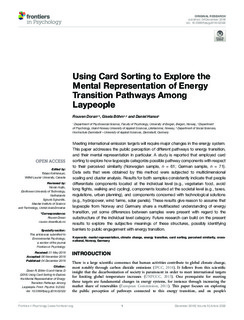| dc.description.abstract | Meeting international emission targets will require major changes in the energy system. This paper addresses the public perception of different pathways to energy transition, and their mental representation in particular. A study is reported that employed card sorting to explore how laypeople categorize possible pathway components with respect to their perceived similarity (Norwegian sample, n = 61; German sample, n = 71). Data sets that were obtained by this method were subjected to multidimensional scaling and cluster analysis. Results for both samples consistently indicate that people differentiate components located at the individual level (e.g., vegetarian food, avoid long flights, walking and cycling), components located at the societal level (e.g., taxes, regulations, urban planning), and components concerned with technological solutions (e.g., hydropower, wind farms, solar panels). These results give reason to assume that laypeople from Norway and Germany share a multifaceted understanding of energy transition, yet some differences between samples were present with regard to the substructure of the individual level category. Future research can build on the present results to explore the subjective meanings of these structures, possibly identifying barriers to public engagement with energy transition. | |
